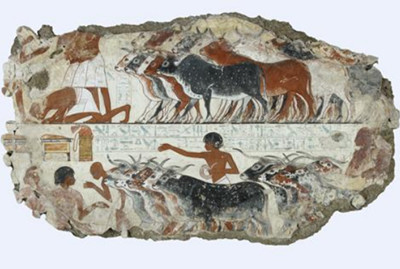Mention excavation in Egypt, and most of us immediately see ourselves entering Tutankhamun's tomb, discovering the hidden treasures of the pharaohs and at a stroke rewriting history. Aspiring archaeologists should be warned that this happens only very rarely.
提及在埃及的考古挖掘,我们绝大多数人自然而然地就联想到进入图坦卡蒙的法老陵墓,挖出隐藏多年的法老大宝藏,于是乎,一夜改写世界历史,一举成名天下名。可别说我要打击那些胸怀抱负、满腔热情的未来考古学家啊,事实上这种情况是极少发生的。
Most archaeology is of course a slow dirty business, followed by even slower recording of what has been found. And the tone of archaeological reports has a deliberate, academic, almost clerical dryness, far removed from the riotous swagger of Indiana Jones.
大多数的考古工作真是又累又苦,又慢又脏;逐一记录下发掘出来的有用没用的物品的过程,就更别提有多缓慢了。而且考古报告的基调几乎千篇一律的学术味十足、几乎是文书干燥的调调,与大家印象中“守宝奇兵”的缤纷招摇可是相去甚远。
In 1900, a member of the Egypt Exploration Society excavated a grave in southern Egypt. He soberly named his discovery Grave A23 and noted the contents:
1900年,埃及探索学会的某一成员在埃及南部发掘处一处墓葬,他正而八经地将这发现命名为墓A23,并记录其中发现成果如下:
'Body, male. Baton of clay painted in red stripes, with imitation mace-head of clay. Small red pottery box, four-sided, 9 inches x 6 inches. Leg bones of small animal. Pots and - stand of 4 clay cows.'
“遗体,男性。泥塑棍棒,表面涂有红色条纹,顶端是仿狼牙棒头。方型小陶盒,四面9英寸x 6英寸,内装:小动物脚骨。陶罐若干,站立式四牛泥塑模型一件。”
These four little clay cows are a long way from the glamour of the pharaohs, but you could argue that cows and what they represent have been far more important to human history. Babies have been reared on their milk, temples have been built to them, whole societies have been fed by them, economies have been built on them. Without cows there are no cowboys, and without cowboys no Wild West. Our world would have been a different and a duller place without the cow.
当年这四只小小的陶牛与法老们辉煌与伟大真是无从相比,然而你也可以这么说,这些陶牛及其代表的意义在人类历史上可以占有更加重要的地位。人类的婴儿喝着牛奶成长,人类建立起供奉牛的神庙。没有牛就没有牛仔,没有牛仔就没有美国的狂野西部文化。假如没有牛的存在,我们的世界将会变得多么的不同与乏味啊。













